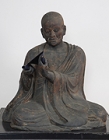Japanese Gallery (Honkan) Room 11
July 10, 2008 (Thu) - September 21, 2008 (Sun)
Rokuharamitsuji, originally named Saikoji, was founded by the priest Kuya Shonin outside the capital of Kyoto (present Higashiyamaku of Kyoto city) in the mid-10th century during the Heian period (794-1192). It became a betsuin (a branch of the head temple) of Tendai Buddhism in 977 and was given its current name. The district around Rokuharamitsuji was adjacent to a mortuary place, where funerals were held and cemeteries were located, and was also popular as a marketplace. Buddhist events were frequently held and attracted many people. Many stories related to the temple are included in collections of stories and legends such as The Anthology of Tales from the Past. In the second half of the 12th century members of the Heike clan had their residences in this area, and in the Kamakura period (1192-1333) the military government in Kamakura had its branch office Rokuhara Tandai there.
Because Rokuharamitsuji continued to attract many people, and also because it was located in a place of political importance, Heian and Kamakura period masterpieces of Buddhist statues have been preserved there. These include: The Standing Jikokuten (Dhrtarastra), produced around the time the priest Kuya established the temple; The Seated Yakushi Nyorai (Bhaisajyaguru), one of the earliest examples of yosegizukuri (joined-block method) work; The Standing Jizo Bosatsu (Ksitigarbha) said to have been sculpted by Jocho, a master sculptor highly esteemed by Heian period aristocrats and respected by sculptors of later generations; as well as works of the Kei school artists including Unkei, the leader of the Kamakura period sculptural world.
We are fortunate to be able to display the statues from Rokuharamitsuji, which seldom leave the temple, here at the Museum on the occasion of the renovation of the temple's treasure house. The display demonstrates how the sculptural style of Buddhist statues changed from the 10th through the 13th century. Please enjoy them at your leisure.
Because Rokuharamitsuji continued to attract many people, and also because it was located in a place of political importance, Heian and Kamakura period masterpieces of Buddhist statues have been preserved there. These include: The Standing Jikokuten (Dhrtarastra), produced around the time the priest Kuya established the temple; The Seated Yakushi Nyorai (Bhaisajyaguru), one of the earliest examples of yosegizukuri (joined-block method) work; The Standing Jizo Bosatsu (Ksitigarbha) said to have been sculpted by Jocho, a master sculptor highly esteemed by Heian period aristocrats and respected by sculptors of later generations; as well as works of the Kei school artists including Unkei, the leader of the Kamakura period sculptural world.
We are fortunate to be able to display the statues from Rokuharamitsuji, which seldom leave the temple, here at the Museum on the occasion of the renovation of the temple's treasure house. The display demonstrates how the sculptural style of Buddhist statues changed from the 10th through the 13th century. Please enjoy them at your leisure.

